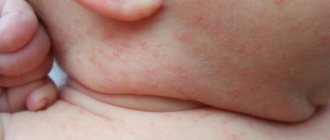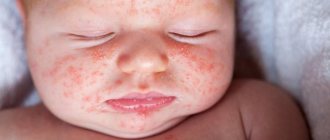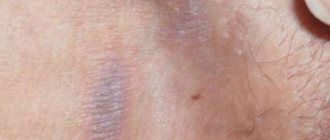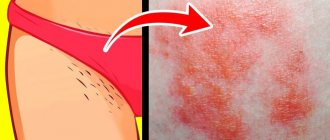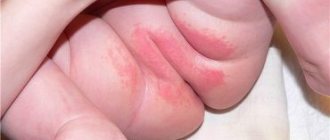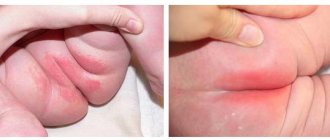About the disease
Diaper rash is irritation of the baby's delicate skin due to mechanical friction or secretions (urine, feces).
The skin often suffers in natural folds (perineum and under the arms). Inflammation primarily occurs without infection, especially with a change in diet, which changes the properties of feces. However, due to the nature of children's skin, a bacterial or fungal infection can quickly develop, requiring immediate treatment. Diaper rash most often occurs in girls and boys who are bottle-fed, who are overweight, who have digestive disorders, who are prone to allergies, who have lactase deficiency, or abnormal kidney development. Excessive wrapping, high room temperature, untimely bathing, prolonged stay in wet diapers or a diaper of the wrong size contribute to the development of diaper rash.
Degrees
Experts distinguish three degrees of development of diaper rash:
- The most gentle option, in which there is redness of the skin, but no serious damage.
- The color intensity intensifies at this stage. Cracks and pustules form on inflamed skin, and erosion is possible. The skin becomes rougher to the touch.
- The most dangerous stage in which diaper rash is wet. On the inflamed surface there are erosions and ulcers (spotting is possible). The baby experiences a burning sensation, has problems sleeping, and general health worsens.
Classification of diaper rash in a child
Experts identify several types of skin diaper rash in children , which largely determine the choice of treatment for the pathology:
- diaper dermatitis - redness and rash appear only in those places that are constantly in contact with wet diapers;
- allergic ring - occurs around the anus due to a food allergy that develops to a new food product;
- seborrheic eczema - the skin of the lower abdomen and genitals becomes rough, swollen, oily to the touch, the border with normal skin is clear, looks like a hyperemic (bright red) huge spot;
- intertrigo - affects natural folds (gluteal, elbow, popliteal and others), against the background of redness, weeping cracks form, this condition is provoked by increased humidity;
- genital candidomycosis - occurs when a fungal infection is attached, has the appearance of red spotty rashes;
- impetigo - occurs when a pyogenic infection occurs; it first appears as separate and then small draining ulcers, which form crusts after drying. Impetigo in children forms on the buttocks.
Possible complications
Stage 1 diaper rash is usually easily cured even without medication. However, if the disease has been ignored for a long time, it becomes quite difficult to fight it - drug treatment is required, constant monitoring of the course of the disease by a specialist, despite the fact that even these measures are not always able to save a small patient from the threat of complications. For example, from a fungal infection, which is expressed in the form of the most dangerous form of diaper rash - impetigo.
A secondary infection added to the underlying disease can cause skin sepsis.
Degrees and symptoms of diaper rash in a child
There are three degrees of severity of diaper rash in children, each of which is characterized by specific symptoms:
- Grade 1: mild damage, in which small areas of redness are found on the skin;
- 2nd degree: moderate damage, characterized by the appearance of bright red erosions with a large number of small cracks, less often pustules;
- 3rd degree: severe and extensive skin damage with the formation of constantly weeping cracks, the appearance of blisters, erosions and ulcers; in this case, there is a high risk of infectious complications.
The baby's behavior with first-degree diaper rash does not change in any way; skin damage is detected when changing diapers. In the second degree, the child is bothered by burning, pain and itching, which is manifested by tearfulness, moodiness, anxiety, and poor sleep. The addition of a bacterial infection is manifested by an increase in body temperature, loss of appetite and other general symptoms.
Types of infectious diaper rash
With diaper rash, optimal conditions are created for infection of the affected areas. The most common intertrigos are fungal and streptococcal in nature. Streptococcal diaper rash is more common in the folds behind the ears, candidiasis and mixed rash - in the inguinal-femoral and intergluteal folds, under the mammary glands in women.
Candidal diaper rash
Fungi of the genus Candida are saprophytes of the skin, its permanent inhabitants. Against the background of inflammation in conditions of increased sweating, fungi acquire pathogenic properties and begin to actively multiply. Candida diaper rash is often recorded in people with reduced body resistance, including diabetes mellitus. The lesions are localized mainly in the folds under the mammary glands, in the groin and in the folds of the abdomen in women, in the inguinal-scrotal region and anus in men, in the interdigital spaces of the hands and feet.
In large folds, small vesicles first appear, which quickly open, and erosions appear in their place. Further, the area of erosion due to peripheral growth increases in size, forming large areas of dark red lesions with a shiny and moist surface and clear boundaries. The shape of the lesions is irregular; along the periphery, a white strip of exfoliating epidermis and foci of elimination are formed. Painful cracks form in the depths of the folds. The rash is accompanied by severe itching.
Due to excessive sweating of the feet, diaper rash may develop on the legs. Infection with yeast-like fungi ranges from 2 to 5%. The lesions are most often localized in the 3rd and 4th interdigital folds. The skin in these places macerates, peels off and acquires a whitish color. Cracks form deep within the folds. Patients are concerned about burning and itching, and when bacterial flora is attached, pain occurs. The course of the disease is persistent and prone to relapse.
Rice. 14 and 15. Redness, irregular shape of the lesions, the presence of exfoliating epidermis along the periphery in the form of a white fringe and dropout lesions are the main signs of candidal intertrigo.
Rice. 18 and 19. The photo shows candidal diaper rash in the folds of the abdomen of a man and a woman.
Rice. 20 and 21. The photo shows candidal diaper rash in the anal area.
Rice. 16 and 17. Diaper rash in the interdigital spaces on the hand and foot. A fringe of dead epidermis is visible along the edges of the lesion, with reddened skin underneath.
Candidal diaper rash in men
Intertrigo in men occupies a special place among diaper rash. The skin in the inguinal-scrotal area is especially delicate and with increased moisture, friction and contact with urine quickly becomes inflamed. This is facilitated by excessive sweating, insufficient ventilation, excessive hair growth and wearing clothes made of synthetic fabrics. With the disease, significant infiltration of the skin is observed, severe itching appears, and significant scratching leads to the formation of pronounced weeping lesions.
Rice. 22 and 23. The photo shows yeast diaper rash in the groin of men.
Rice. 24 and 25. In the photo, candidal diaper rash in the groin of men. On the right side of the photo, dropout areas are clearly visible along the periphery.
Streptococcal diaper rash
In some cases, diaper rash is complicated by a bacterial infection. The main causative agent is group A beta-hemolytic streptococci (GABHS, S. pyogenes). The disease is most often recorded in patients with diabetes mellitus.
Streptococcal intertrigo is characterized by the appearance of many blisters on fairly large areas of hyperemic skin. The lesions quickly open and a continuous eroded surface is formed. Deep painful cracks form in the depths of the folds. Patients are bothered by itching, burning and pain. With prolonged exposure to provoking factors, the disease takes on a long course.
Rice. 26 and 27. Streptococcal intertrigo of the intergluteal region.
Causes of diaper rash in a child
Diaper rash occurs in almost every baby, even with ideal care. This happens because the skin is the most vulnerable part of a baby’s body. Children's skin is thin and loose, its protective function is not fully formed. When soaked in liquid, the skin of children swells (macerates), which contributes to damage even with a slight touch.
In children of the first year of life, the so-called water-lipid mantle is not sufficiently formed - the first skin barrier, a film on the stratum corneum of the epidermis. All other barriers - cellular, humoral - are also underdeveloped due to age. Therefore, babies are susceptible to local bacterial infection, which quickly spreads from the primary focus to the underlying skin.
The immediate cause is prolonged contact with moisture, which is formed during the breakdown of urea. Feces contain enzymes (protease and lipase) that literally eat away at the skin. With diarrhea, diaper rash can develop within a few hours.
Some children's skin may react to certain components of baby cosmetics, a new brand of diapers, or other hygiene products. This does not mean that children's products contain low-quality components, it is just that the child has increased individual sensitivity to certain substances.
How to quickly cure with folk remedies
There are, perhaps, even more options for traditional treatment of diaper rash than ready-made pharmaceuticals, but they require great care in use and must be agreed with the pediatrician - there is a high risk that some of them may cause an allergic reaction in the child.
Here's what can help against diaper rash in a baby:
- potato starch (or corn) as a substitute for powder;
- decoction of oak bark or string for healing baths;
- ointment prepared from Vaseline and infusion of birch buds;
- plantain juice, which can be used to smear areas of inflammation;
- lotions from violet leaves, crushed to a paste;
- a decoction of yarrow for healing microcracks.
Treatment of diaper rash in a child
The choice of treatment method for diaper rash in newborns depends on the degree, volume and location (in the groin, legs, etc.) of the lesion, as well as the individual characteristics of the child’s body.
In most cases, outpatient care and careful skin care are sufficient. Treatment of stage 1 diaper rash in infants is, first of all, close attention to daily procedures. It is advisable to change diapers and diapers more often so that the baby's skin is not wet. When swaddling, it is advisable to wash the buttocks and genitals, especially after defecation, and allow the skin to dry naturally. After this, you need to lubricate the problem areas with baby cream. It’s good if the baby takes air baths (lying naked for a while). After an evening bath, you need to wait until the baby is completely dry and only then swaddle.
In the treatment of stage 2 and 3 diaper rash in children, the following medications are used:
- drying;
- antiallergic;
- anti-inflammatory;
- wound healing;
- antiseptic.
By combining careful care and local medications prescribed by a doctor, it is always possible to cope with diaper rash in a short time.
List of sources
- Ryumina I.I. Prevention and treatment of diaper dermatitis in a neonatology hospital / Issues of modern pediatrics / 2015/ VOLUME 14/ No. 2.- p. 298-299.
- Garina S.V., Soldatova O.N., Tumaeva T.S., Balykova L.A. Modern ideas about the mechanisms of occurrence and approaches to the treatment of diaper dermatitis // Attending physician. — 2014. -No. 5.
- Koval G.S. Prevention and treatment of diaper dermatitis // Issues of modern pediatrics, 2004, vol. 3, no. 5, pp. 60-64.
- Studenikin V.M., Studenikina N.I. Diaper dermatitis: prevention, treatment, extradermal aspects / Attending physician. - 2009. - No. 3.
- Zaplatnikov A.L. Prevention and treatment of diaper dermatitis in children // Current issues in the development of children. 2008.No. 4. P. 24.
Prevention of diaper rash in a child
Preventive measures are varied and based on centuries of experience in caring for an infant.
Everything that touches children's delicate skin should be natural, including fabrics and cosmetics. Synthetic items should be avoided. When bathing, you need to thoroughly rinse all folds. After each bowel movement, the baby is washed with warm water, sometimes several times in a row, until completely clean. Once or twice a week it is recommended to bathe in a weak decoction of string or chamomile. From time to time, all diapers and diapers need to be removed, giving the baby the opportunity to move his arms and legs freely, and the skin to “breathe.” If the first signs of inflammation appear on the skin, suspicious areas should be treated with a weak (pink) solution of manganese. Afterwards, do not wipe it off, but let it dry. The baby should be closely monitored, and if the inflammation does not go away within 1-2 days, contact a pediatrician.
You should also pay close attention to complementary foods. It is unknown how the baby will react to the new product. The first fruit or vegetable complementary food should consist of only one vegetable or fruit. The same applies to cereals, dairy and meat products. You can mix products only after each individual product has been tested for tolerance. A new product should be given for the first time in a small portion (about 1 teaspoon) so as not to cause harm.
Powders and oils used for care should also be tried separately.
Children's doctors at the SM-Doctor clinic have extensive practical experience. Experts will advise you on the best care products and help you quickly get rid of diaper rash. Contact qualified pediatricians so that your baby can live an active and joyful life!
Stages of development of diaper rash
The symptoms of diaper rash are easy to identify by eye and are quite specific. A mild degree of diaper rash should not cause panic, because with timely and proper care, this skin irritation can be quickly eliminated. But subsequent stages of the disease can subsequently cause a lot of problems that can be dealt with for years. Diaper rash in the second and third stages of development is classified as a dermatological disease.
- Diaper rash at the first stage is called erythematous. The skin at the site of the lesion has slight redness. If there is increased sweat and sebum production in this area, the skin will be constantly hydrated. It is important to eliminate friction at this stage; this will help stop the development of the problem and solve it yourself.
- At the second stage, irritation between the folds of the skin joins the redness. If the problem is not noticed in time, the condition of the skin will begin to rapidly deteriorate. Sweating, increased sebum secretion and, of course, friction will aggravate the problem. Skin can rub against skin or against clothing; tight clothing and unnatural fabrics are especially dangerous in this regard.
- At the third stage, the problem reaches the level of disease. In addition to irritation and redness, cracks appear on the skin, which turn into wounds. Overhydration and friction are complemented by an attached infection (its occurrence is more than likely). All this leads to the development of serious damage to the skin, which is simply impossible to cope with on your own without medical help.
Urinary and fecal incontinence are also common causes of diaper rash in older women. In the absence of timely hygiene, high humidity and the specific composition of secretions have an extremely adverse effect on the skin and lead to irritation.
We recommend
“Hip fracture in older people: symptoms, treatment and rehabilitation” Read more
What to do if you sweat under your breasts: preventing trouble
To prevent the appearance of diaper rash under the mammary glands in hot weather, you need to follow a number of simple rules:
- Wear comfortable, breathable underwear without hard elements.
- Use baby powder if you sweat profusely.
- Take a shower 2 times a day.
- Thoroughly wipe the folds under the breasts after bathing.
- Do not change cosmetic products frequently.
- Change underwear after excessive sweating.
These simple tips will help make even diaper rash under the breasts in older women less likely. If the disease does occur and progresses, you should immediately consult a doctor.
You can ask your question to our author:
How to get rid of prickly heat under the breasts?
To get rid of mild prickly heat under the breasts, it is enough to take a shower 2-3 times a day. After active sweating, it is advisable to wash yourself additionally. Baths with decoctions of string, oak bark, and chamomile are recommended. After a shower, you can dry your skin with baby powders, zinc emulsions or Bepanten and Sudocrem creams.
To prevent infection, the area under the breast should be treated with solutions of chlorophyllipt or potassium permanganate. The antifungal fucorcin and methylene blue permanently stain clothes, so they must be used with caution.
In case of severe itching, additional antihistamine or hormonal ointments are prescribed: suprastin, tavegil, kremgen. If inflammation spreads over a large area, internal use of antiallergic drugs is also possible (during pregnancy, only after consultation with a gynecologist).
If there is a stink under the mammary glands, then this is a reason to prescribe local or systemic antibiotics, but these drugs can only be used after visiting a doctor.
Miliaria can always be cured with adequate therapy; the main thing is not to self-medicate in severe forms of this disease.
Mechanism of development of deviation
The inflammatory process leading to the formation of diaper rash in the groin in women and men of any age begins as a result of friction of the surface of the epidermis against clothing/bed, increased sweating, increased humidity, a large volume of sebum, and overheating of the body.
The most susceptible to dermatological disorders are:
- babies;
- aged people;
- bedridden patients;
- obese people;
- sloppy people who neglect to care for their own bodies;
- people suffering from hyperhidrosis.
Under certain conditions, an inflammatory process on the skin can develop anywhere where there are skin folds.
